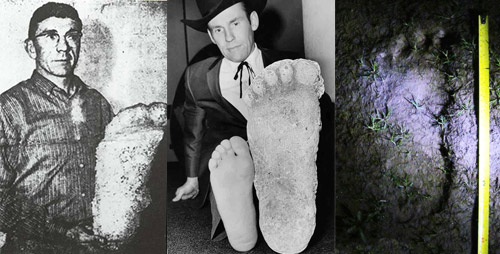For hundreds of years, alleged Bigfoot footprints have been found all over the wilds of North America. Hundreds of compelling plaster casts are made from these prints. The impressively large indentations typically measure at least 14” long and vary in width, shape, and depth.
The term “Bigfoot” comes from the first highly-circulated news-feature about these mysterious prints. In 1958, road-construction worker Jerry Crew happened upon increasingly frequent sets of deep, 16” bare-footed prints circling his deep-woods construction site. The prints featured a consistent 50” stride and went up and down steep embankments before fading in the woods. This fateful event also shifted focus from the Abominable Snowman in the Himalayas right to America’s backyard.

Left to Right: Jerry Crew and cast (1958), Roger Patterson and cast (1967), London OR trackway print (2012)
Challenged by many, these important pieces of Bigfoot evidence garner serious academic oversight. The late anthropologist Dr. Grover Krantz was the first researcher to devote extensive study to these footprints, and maintained an unwavering belief in the creatures because of this evidence. Foot morphology and primate locomotion expert Dr. Jeff Meldrum of Idaho State University, routinely supports the existence of Bigfoot after having evaluated hundreds of supposed Bigfoot footprints.
While many casts are likely born from hoaxing minds, how likely is it that every single one is fake?
